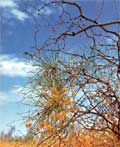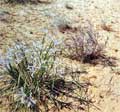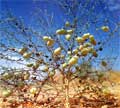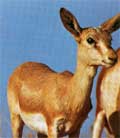Deserts of Uzbekistan
Silence brings peace...
The caravan paths crossed the vast, scorching land - the Great Silk Road connecting ancient China with Europe. The wells were carefully kept, the only salvation for travelers and caravans along the boundless sands.
The modern deserts of this region however, are not so lifeless. In the old days, Amir Timur's vessels floated down the Uzboy - the ancient course of the Amudarya. Abulghazi, a famous scientist of Khorezm in the 16th century wrote: "... the way from Urgench to Abul-Khan (Balkhan) was full of wells because of the Amudarya River, which streamed along the walls of Urgench to the eastern slopes of the mountain where the river turned southwest and later west into the Mezandiran (Caspian) Sea".
The Karakum was formed by the sandy sediments of the ancient Amudarya, and in the south, by the flows of the Murgab and Tejen rivers. It is here where ancient and modern deltas are extended. However, from this point there is not a river along the entire length of the Kizilkum. Sand dunes form the greatest part of the desert - the height of which ranges from 3 to 75 meters. It is terrible when they begin to "emit". The wind takes millions of grains of sand off their tops and blows them far away. This sand, when in the desert, chokes one's mouth, making it hard to breath.
The climate of the Central Asian deserts is severe. There are icy winds and frosts in winter, while temperatures reach 50 degrees centigrade in the shade in summer. There are boundless expanses where it is easy to get lost, lost in one's own fascination. This is especially true in spring, during that short period when nature is adorned with "watercolors" as if it is tired of waiting for the heat. By the end of May everything fades, stands still, dies away, and falls into hibernation until autumn.
Sanderlings are "guests"
If visiting for the first time; it is the silence that is the most impressive. Only insects hum and chirr on the sand. Suddenly a tuneful whistle will be heard from below. Sometimes the whistle is heard at the same time in several places. The sander lings are singing. And although these wild beasts are the size of a rat, one doesn't notice them immediately. They stand near their holes like "columns", straight-backed.
Sanderlings live in groups. Sometimes one may notice up to a hundred holes in one place and quite often they are 2 or 3 stories deep, like the houses of the famous hobbits. Their network of underground passages is a complete labyrinth. Using the paths between their burrows, sanderlings like to visit each other.
Caravans traveling through the desert would have to go around sanderling colonies because it is not only difficult, but also dangerous to walk on such sand. Horses, camels and even men could disappear into the collapsed passages.
The thin-pawed gopher is considered to be the biggest of the desert-dwelling animals. The gopher is an individualist as opposed to the sanderling. He is quite often called a "hermit" because of his love of solitude. A pair of gophers will often live in a burrow. The gophers are day creatures like sanderlings. His thin, long fingers are covered with bristles and are used to move on the sand. The golden, sandy-colored, delicate and rather long fur which is very precious grows long during winter. Like many other dwellers of the desert, the thin-pawed gophers get water from the plants they feed on. They mostly eat the stems of the sandy sedge but they also eat insects. By the end of May, when the vegetation of the desert fades, gophers hibernate until September.
Nightlife is much richer in the desert. One of the most marvelous night animals is the moss-legged jerboa, named for the thick fur on his toes of his back legs. It forms a wide cushion on the sole and allows movement without sinking into the soft sand.
The back legs of jerboa are considerably larger than those in the front. They jump into the air as if flying, touching the ground only for a moment. They can jump as high as 1.5 meters, 10-12 times more than its body length. The jerboa holds food and digs holes with his front paws.
Being tired, the jerboa gets under a bush where he sits hiding his head between the front paws. The jerboa may be recognized by the black and white tassel of his tail - "banner", in such pose. But quite often it saves the life of the animal. When running, the jerboa is difficult to view; only the banner is noticed clearly. But now the beast throws aside his long tail abruptly, "the banner" is brightly glimpsed; a predator throws himself upon the jerboa. And the jerboa turns round sharply at this moment and rushes in the opposite direction.
While the enemy notices his mistake the jerboa is far in the distance. One more creature not found anywhere but in the desert dwells in the "red" and "black" sands. This is the skewbald shrew. Being lively like her all relatives, she is a brave and smart beast. She eats insects but quite often attacks animals which she may overpower.
Traces on the sand
Quaint patterns run in different directions in the desert, but only experts may read the life of the inhabitants of this book.
... Here are the trails of sandy rabbits and big-eared hedgehogs. And here are the beads of footsteps of the haloxylon jays. This is a ground bird which settles nowhere but in deserts. But she prefers to make nests on the branches of haloxylon and covers it with a roof of thin branches. The jays guard their nestlings carefully. While the female is sitting on the eggs, the male stays next to the nest and he often looks around their territory, reaching to tens of metres. When an enemy attacks the male lets out a special trembling whistle and the female takes away her nestlings, hiding them under the roots of bushes or in a hole. For winter the jay stores food supplies by burying them in a pit or concealing them in a hollow.
Those who are lucky may hear the breeding song of the field horse. This small grey bird sings in the air, now rising into the air obliquely, now falling to the ground. After the first horse, a second and third one rise not far off...
But the first thing striking a traveler in the desert is the lizard. They are everywhere: they jump out from under the legs and hide behind a bush or stand still and watch you attentively. Most of them are met nowhere but in deserts.
For example, the big-eared round head dwells in mellow sands. She has horny combs on the fingers of her paws, increasing her foot area and allowing her to run on the sand. In the heat a round head hides in a hole or climbs up the crests of sand-dunes. The lizard stands on its paws highly and raises its tail, screwed in a spiral upwards. The coloration of the big-eared round heads mingles with the color of the sand, and that is why it is almost impossible to notice a hiding lizard. Sensing danger, the lizard presses itself to the soil and then, moving her trunk 2-3 times, sinks into the sand as into the water. Loose sand is seen where the lizard has just been sitting.
If the hiding is not successful, the lizard attacks the enemy bravely. Getting up she opens her large mouth widely and lets out parotid folds which become bloodswollen. And she also hisses and jumps. The look of the round head becomes so terrifying that you pull your hand back involuntarily. A bigger lizard, the reticular scapteira, dwells in deep wavy sands, overgrown with rare grassy vegetation and bushes. She makes holes under the bushes, hides from enemies and obtains food near the roots. Reticular scapteira is one of the most dexterous and careful lizards.
But the striped scapteira excels her in speed and smartness. This thin slender lizard disappears so quickly that you don't notice the direction she vanished. The striped scapteira not only runs on the ground, but also climbs bushes. In complete contrast is the skink gecko. It has a big head and huge eyes. And its scales are like a fish's. This lizard spends all day in a hole or lies rummaging in the sand. She goes out only in darkness. If you shine light on a running gecko at night, it will stop and freeze, rising to his paws and drawing its tail upwards. You may come and grab him. The gecko runs slowly, but is sure-footed.
And certainly, the famous giant lizard, reaching 1.5 meters in length, demands patience to be seen.
People especially like to talk about the snakes of the desert. Epha, Central Asian cobra, gursa, steppe boa, arrow-snake, grass-snakes... We shall discuss only two sandy inhabitants. The sandy boa, caught on the surface, doesn't take to flight but "dives" into the sand, moving freely in its thickness. Watching over his prey, he lays motionless, hiding under the sand. Only his nostrils and eyes stick up outside, being situated on the upper part of the head. It seems improbable that this fat clumsy bumpkin may catch the fast moss-legged jerboa or scapteira, but it is true. Catching his quarry, the boa kills it instantaneously.
The total opposite to the sandy boa is the arrow-snake. This thin, elegant creature with a small head is notable for its swiftness. Even the quickest lizard cannot escape from her. Even a fast-running man may hardly catch the arrow-snake taking flight.
The desert is a sunny country. The sand reaches 80 degrees in summer. An egg, when stuck into the sand, is instantly baked. While a weevil is crawling, getting up on his long paws, he still bears the heat of the sand. He has only to touch the sand with a limb when suddenly he dies. For instance, the round head stands and runs on extended legs with a screwed in tail. The lizard agama never sits on the earth in the heat, she settles down on the haloxylon branches or on the top of a bush, where the unbearable heat doesn't bake her from the bottom. If the scapteira comes out of its hole in broad daylight, then she sits under the protection of bushes: it is still cooler there and the sand doesn't become so hot.
The quickness of many residents on the open spaces is necessary, not only for escaping from enemies. It is necessary for rescue from the burning heat or soil. There are plants growing in the hottest months in the desert. They reach water with their long roots, giving food and water to the inhabitants of the deserts. The sandy sedge, white haloxylon, and calligonum are typical for sandy massifs. And the wormwood and wormwood-shrub vegetation is typical for this ecosystem.
Desert and man
"Clouds thickened, wind blows, sandy grass makes a noise," wrote the poet Alexey Koltsov. It is a severe land but man has lived here from the earliest times. These days, the covered ruins of towns testify to this. The wind of time rustles the sand, singing its sad song
And in spite of the hardships, man has assimilated these vast areas. Today, the Kizilkums are famous for their large deposits of natural gas - Gazli and Shurtan in Uzbekistan. The main gas center of Central Asia stretches across the Karakums. The "blue" fuel of Central Asia travels through a gas main into Russia and Ukraine.
Bek Tashmukhamedov, a prominent scientist of Uzbekistan and academician of the Academy of Sciences of our Republic, considers that the biological potential of the deserts has not been fully utilized. Increasing the productivity of each sandy hectare, man can receive many useful products. Our deserts are the center of an ancient world of species. Here pre-cainozoic endemics are concentrated: a design that you may see nowhere else in the world. "The steppe, keeping its silence is boundless; it draws with its yellowness..."









